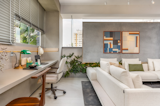Beyond Minimalism: Redefining Sustainable Spaces for Modern Living
Credits
From Teresa Supi
Introduction
In an era where sustainability has become a non-negotiable priority, architecture and interior design are evolving beyond aesthetics to embrace eco-conscious functionality. Today’s homeowners seek more than beautiful spaces—they demand designs that harmonize with the environment while enhancing their lifestyles.
This article explores how designers are redefining sustainable spaces, focusing on innovative materials, multifunctional layouts, and the integration of biophilic elements.
Main Content
1. The Rise of Green Architecture
The modern sustainable home is no longer just about solar panels or energy-efficient appliances. Architects are incorporating passive design strategies, such as maximizing natural light and optimizing airflow, to reduce energy consumption. Homes like the “Treehouse Studio” in Portland, Oregon, showcase how architecture can blend with nature, using reclaimed wood and green roofs to reduce ecological footprints.
2. Innovative Materials with Purpose
Material innovation is at the forefront of sustainable design. Recycled glass countertops, bamboo flooring, and bio-composites are becoming staples in modern homes. Brands like Ecoclay and Mushroom® Mycelium Furniture are pushing boundaries by offering biodegradable and durable materials that merge functionality with environmental stewardship.
3. Biophilic Design: Connecting Indoors and Outdoors
Biophilic design emphasizes the connection between humans and nature. From living walls to indoor gardens, designers are weaving natural elements into interiors to boost mental well-being. A striking example is the “Urban Jungle” apartment in New York City, where vertical gardens and expansive windows bring the outdoors inside.
4. Multifunctional Spaces for Modern Living
With remote work becoming a norm, multifunctional spaces are a necessity. Designers are crafting adaptable layouts that transform living rooms into offices or guest rooms. This trend is exemplified in the “Compact Living” project by Studio MK27, where every square foot serves multiple purposes without compromising on aesthetics.
Conclusion
As the demand for sustainable, adaptable, and biophilic design grows, the architecture and design community must continue to innovate. By embracing new materials, fostering human-nature connections, and optimizing spaces for modern needs, we can create homes that are not only visually stunning but also align with the principles of a greener future.
Call to Action
Design is more than an art—it’s a responsibility. Let’s reimagine our living spaces to contribute to a sustainable and harmonious world.




